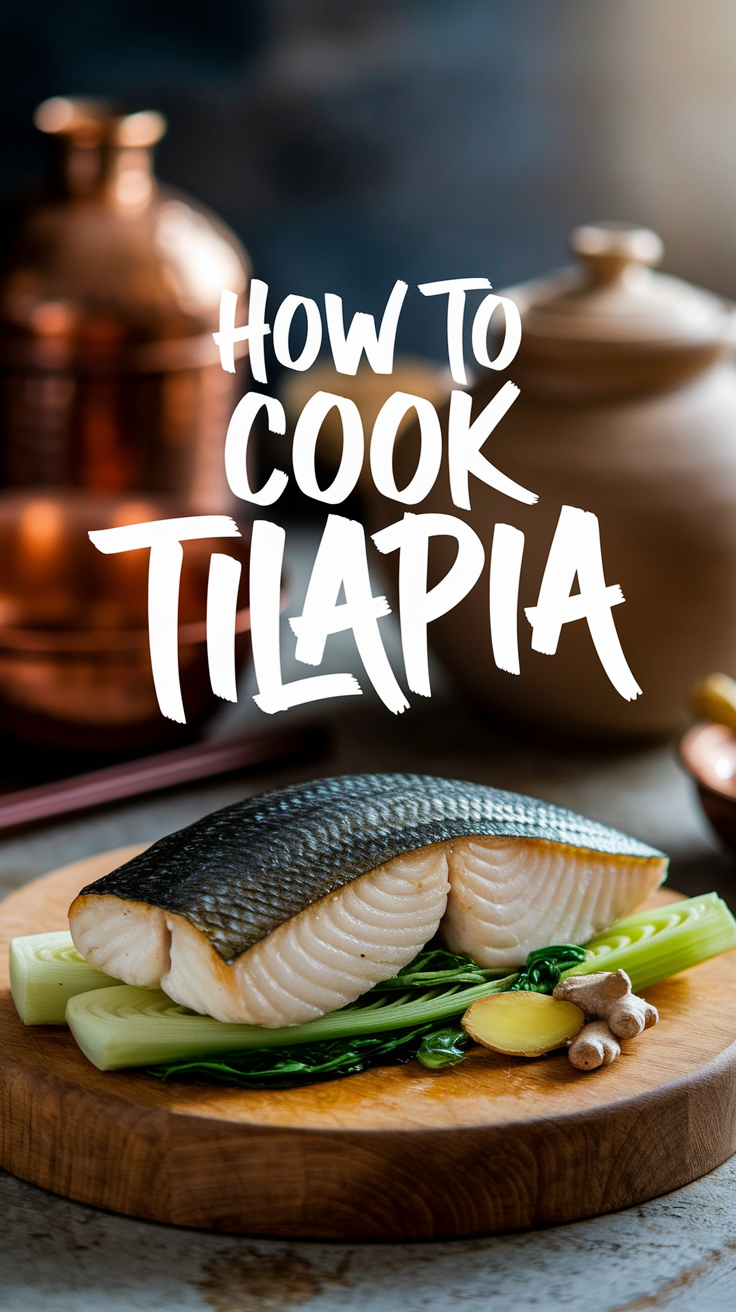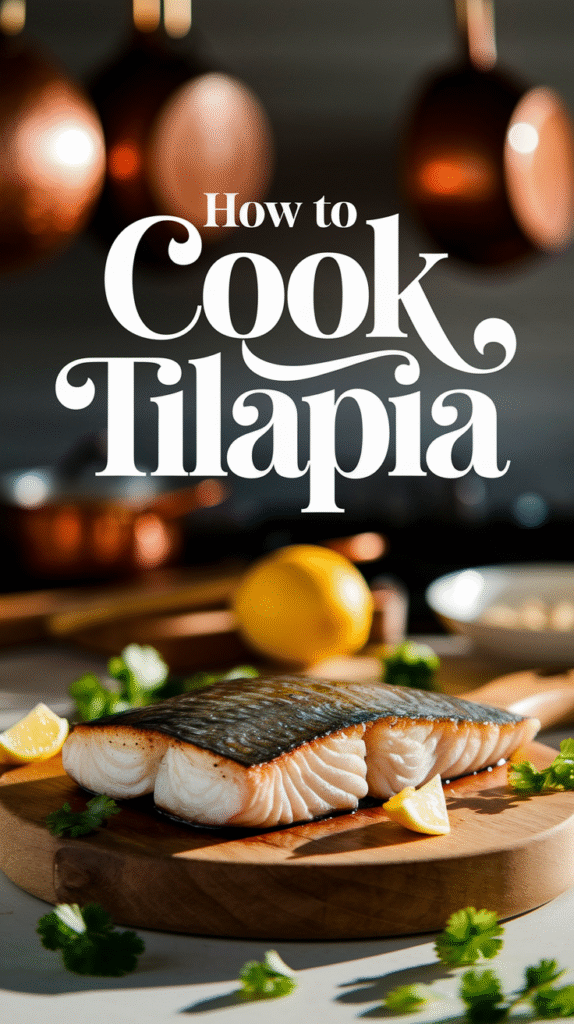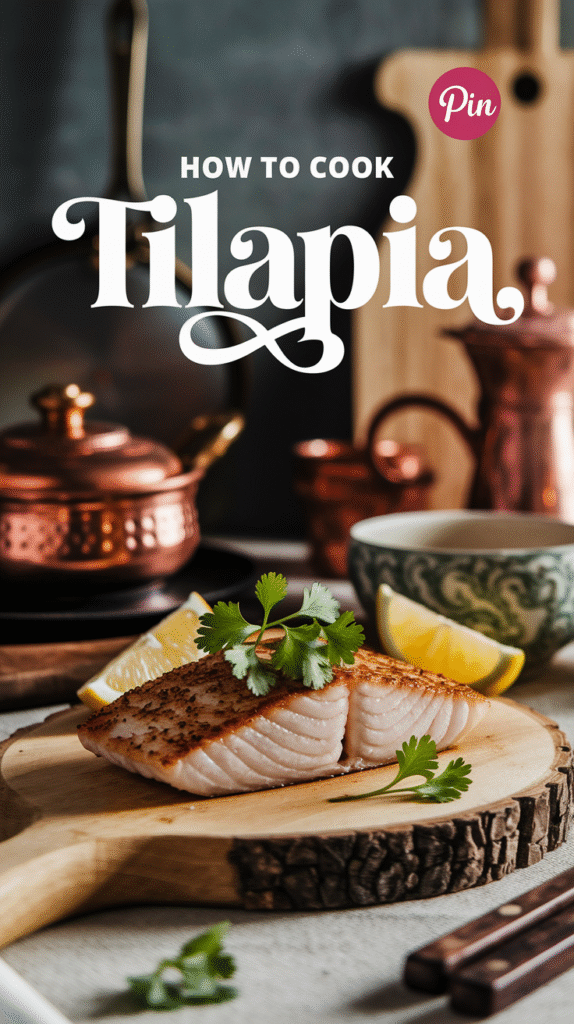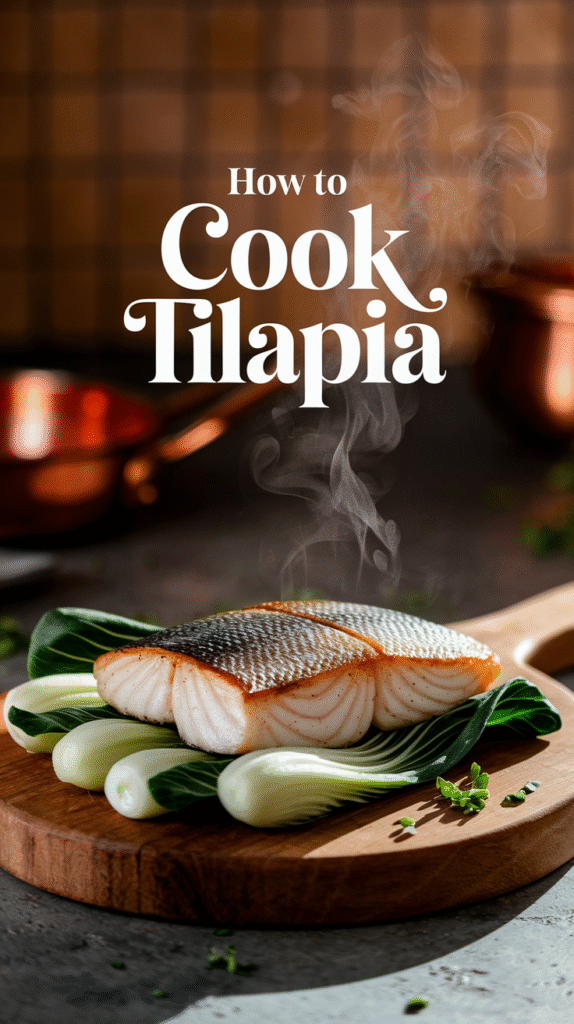Tilapia is a versatile and mild-tasting fish that can easily become a favorite in your household. It cooks quickly and takes on flavors well, making it a great choice for a variety of recipes. Whether you’re grilling, baking, or sautéing, knowing how to cook tilapia will help you create delicious meals that everyone will enjoy. Below, we will explore a few easy methods to prepare tilapia, highlighting the flavors and techniques that will make your dish a success.
Grilling Tilapia
Grilling tilapia adds a smoky flavor that perfectly complements its mild taste. Here’s a simple way to grill your tilapia:
- Preparation: Begin by thawing the tilapia if it’s frozen. Rinse it under cold water and pat it dry with paper towels.
- Seasoning: Coat the fish with olive oil, salt, pepper, and your choice of herbs or spices. Lemon juice or garlic can also add a nice touch.
- Preheat the Grill: Make sure your grill is preheated to medium heat.
- Grill the Fish: Place the tilapia directly on the grill for about 4-5 minutes on each side, or until the fish is opaque and flakes easily with a fork.
Baking Tilapia
Baking is another excellent method for cooking tilapia, especially if you want a no-fuss, hands-off approach. Follow these steps to bake tilapia:
- Preheat the Oven: Set your oven to 375°F (190°C).
- Prepare the Dish: Lightly grease a baking dish with butter or cooking spray.
- Season the Fish: Place the tilapia in the dish, season it with your preferred spices, and add a slice of lemon on top for extra flavor.
- Bake: Bake for 15-20 minutes, or until the fish is cooked through and flakes easily.
Sautéing Tilapia
Sautéing tilapia is a quick method that keeps the fish moist. Here’s how to do it:
- Heat the Skillet: Add a tablespoon of oil or butter to a skillet over medium heat.
- Season the Fish: While the skillet is heating up, season your tilapia fillets with salt, pepper, and any other spices you prefer.
- Sauté: Place the fillets in the skillet. Cook for about 3-4 minutes on each side until golden brown and cooked through.
Tilapia Tacos
If you’re looking to elevate your fish dish, consider making delicious tilapia tacos. You can use any of the cooking methods listed above. Here’s a quick recipe:
- Ingredients:
- Tilapia fillets
- Taco seasoning
- Soft corn tortillas
- Fresh toppings: cabbage, cilantro, diced tomatoes, avocado
- Lime wedges
- Cooking: Cook the tilapia using your preferred method, and then break it into pieces. Serve it on warm tortillas and top with your favorite toppings.
Tips for Cooking Tilapia
Here are some helpful tips to ensure your tilapia turns out perfectly:
- Choose fresh fillets whenever possible for the best flavor and texture.
- Do not overcook tilapia. It should be opaque and flake easily when done.
- Experiment with different seasonings and marinades to find your favorite flavor combinations.
Remember, cooking tilapia can be simple and enjoyable. By using these methods, you can create an array of tasty dishes that suit any palate. For more delicious recipes and cooking tips, visit Tilapia.com or check out FishWatch.gov for sustainability information about seafood.
Now that you know how to cook tilapia in a variety of ways, it’s time to bring these skills to your kitchen. Enjoy your cooking journey, and savor the delicious flavors of tilapia!
The Nutritional Benefits of Tilapia
Tilapia is a versatile fish that has gained popularity in kitchens around the world. Not only is it easy to cook, but it also offers a variety of nutritional benefits that make it an excellent choice for any meal.
This fish is an excellent source of high-quality protein. In fact, a 3.5-ounce serving of tilapia provides around 26 grams of protein. Protein is essential for building and repairing tissues, and it plays a key role in the production of enzymes and hormones. Including adequate protein in your diet can help maintain muscle mass, especially as you age.
In addition to protein, tilapia is low in calories, making it a great choice for those watching their weight. A standard serving contains roughly 128 calories, allowing you to enjoy satisfying meals without the extra pounds. This low-calorie nature encourages balanced meal planning.
Tilapia is rich in omega-3 and omega-6 fatty acids, although it has a lower omega-3 content compared to fatty fish like salmon. Still, these healthy fats contribute to heart health by helping to reduce inflammation and lower cholesterol levels. Consuming tilapia as part of a balanced diet can support overall cardiovascular health.
This fish is also a good source of important vitamins and minerals:
- Vitamin B12: Essential for nerve function and the formation of red blood cells.
- Niacin (B3): Supports digestion, skin health, and the nervous system.
- Phosphorus: Vital for bone health and energy production.
- Selenium: An antioxidant that aids in protecting cells from damage.
Including tilapia in your diet can also help you meet your daily requirements for these nutrients, promoting overall health and wellbeing.
The unique amino acid profile in tilapia contributes to its status as a healthful choice. Amino acids are the building blocks of proteins and play a crucial role in many bodily functions. The beneficial amino acids in tilapia help enhance muscle recovery and growth, making it a favored option among athletes and fitness enthusiasts.
When it comes to cooking methods, tilapia is incredibly accessible. You can bake, grill, broil, or fry it. Each cooking method can enhance its flavor while retaining its nutritional advantages.
Here’s a quick comparison of tilapia with other popular fish:
| Fish Type | Calories (3.5 oz) | Protein (g) | Omega-3 (g) |
|---|---|---|---|
| Tilapia | 128 | 26 | 0.3 |
| Salmon | 206 | 22 | 2.2 |
| Tuna | 132 | 28 | 0.2 |
As seen in the table, tilapia provides a substantial amount of protein while keeping calories in check. Although it has lower omega-3 levels compared to salmon, it still promotes heart health.
One of the best aspects of tilapia is its adaptability. This fish can take on a variety of flavors, allowing you to create diverse dishes. From lemon garlic tilapia to spicy tilapia tacos, the possibilities are endless. You can pair it with a variety of vegetables, grains, or salads for a well-rounded meal.
It’s also worth noting that tilapia is often farmed sustainably. This is a significant consideration in today’s eco-conscious world. Sustainable fish farming practices ensure that you’re making environmentally friendly food choices. For those looking to source tilapia responsibly, check out resources like the Monterey Bay Seafood Watch for information on sustainable seafood options.
The nutritional benefits of tilapia make it a smart addition to your diet, whether you’re looking for high-quality protein or a low-calorie meal option. With its health benefits and the ease of cooking, it’s no wonder tilapia remains a favorite for many. For more information on cooking techniques and recipes, you can visit EatingWell or Food Network.
Choosing the Best Tilapia for Cooking
When it comes to cooking tilapia, choosing the right fish is crucial to ensure a delicious meal. Tilapia is popular for its mild flavor and flaky texture, making it an excellent choice for various dishes. However, not all tilapia is created equal, and making informed choices can elevate your cooking experience. Here’s how to select the best tilapia for your culinary adventures.
Understanding Tilapia Varieties
Tilapia comes in several varieties, and knowing these can help you make a better choice. Common types include:
- Nile Tilapia: Known for its firm texture and mild taste, this variety is often farmed in freshwater. It’s widely available and a favorite among chefs.
- Blue Tilapia: With a slightly sweeter flavor, blue tilapia can be found in both wild and farmed settings. It’s a great option for grilling and frying.
- White Tilapia: This variety is often sold as “Tilapia” in stores. It has a mild flavor and is extremely versatile in different recipes.
Key Factors to Consider
When choosing tilapia, consider the following factors to ensure quality and sustainability:
- Source: Always check if the tilapia is wild-caught or farmed. Wild-caught fish generally have a better environmental profile, while certain farming practices can ensure sustainability.
- Labeling: Look for certification labels such as Marine Stewardship Council or GLOBALG.A.P. These labels indicate that the fish meets specific environmental and sustainability standards.
- Freshness: Fresh tilapia should appear bright and shiny, with clear eyes and a fresh ocean smell. Avoid fish with a dull appearance, brown spots, or a strong fishy odor.
- Size: Choose tilapia fillets that are uniformly sized for even cooking. They should also feel firm to the touch; avoid any that feel mushy or are falling apart.
Where to Buy Quality Tilapia
Finding the right place to purchase tilapia can make a significant difference. Consider the following options:
- Local Fish Markets: Often, local markets offer fresher, higher-quality options directly from fishermen.
- Grocery Stores: Reputable grocery chains usually carry tilapia, but ensure to ask about their sourcing practices.
- Online Retailers: If you prefer shopping from home, consider trusted seafood delivery services. Check websites like Fish Fixe for quality choices.
Health Considerations
Choosing quality tilapia also has implications for your health. Tilapia is a good source of protein and is low in calories, making it ideal for various diets. However, be mindful of potential contaminants such as:
- Heavy Metals: Some tilapia, particularly from polluted waters, can accumulate heavy metals. Always prioritize certified sources.
- Omega-3 Levels: Farm-raised tilapia has lower omega-3 fatty acids compared to wild-caught varieties. If this is important for your diet, look for wild-caught options.
Cooking Tips for Your Tilapia
Once you’ve selected the best tilapia, it’s time to cook it. Here are some methods to try:
- Grilling: Perfect for summer cookouts, grilling gives tilapia a lovely smoky flavor. Simply marinate it, then grill for 3-5 minutes per side.
- Baking: Baking tilapia is easy and healthy. Season the fillets with lemon, herbs, and spices, then bake at 375°F (190°C) for 15-20 minutes.
- Pan-searing: For a crispy edge, heat olive oil in a skillet and pan-sear tilapia for 3-4 minutes on each side.
Selecting the right tilapia involves understanding the different varieties, considering freshness and sourcing, and being aware of health implications. Quality tilapia not only tastes better but also ensures a more sustainable and healthy meal. Enjoy your cooking journey and explore the vast flavors that tilapia can offer!
Flavor Pairings and Seasonings for Tilapia
Tilapia is a delicate fish that lends itself beautifully to a variety of flavors and seasonings. If you’re looking to elevate your tilapia dish, understanding the best flavor pairings can truly make a difference. Here, we explore some of the most popular flavor profiles that complement this versatile fish.
One of the best aspects of tilapia is its mild taste, which allows it to blend well with various spices, herbs, and marinades. When thinking about how to flavor your tilapia, consider these groupings:
Classic Flavor Pairings
- Citrus: Lemon, lime, and orange zest brighten the taste and bring a fresh quality to the fish.
- Garlic: This aromatic ingredient enhances tilapia’s flavor, making it an essential component of many recipes.
- Herbs: Fresh herbs like parsley, cilantro, and dill add depth and complexity.
- Butter: Rich and creamy, butter makes a delightful base for cooking tilapia.
Spice Combinations
When it comes to spices, tilapia can easily take on bold flavors. Here are some excellent spice combinations to consider:
- Southwest Spices: Use a blend of chili powder, cumin, and paprika for a smoky flavor.
- Cajun Seasoning: Try this robust mix of spices for a more zestful kick.
- Italian Seasoning: A combination of basil, oregano, and thyme transports your taste buds to the Mediterranean.
- Ginger and Soy Sauce: Perfect for an Asian-inspired preparation, these two ingredients work harmoniously with tilapia.
Marinades for Extra Flavor
Marinades are one of the best ways to infuse tilapia with flavor. Here are a few delicious marinade ideas to try:
| Marinade | Ingredients | Marinating Time |
|---|---|---|
| Lemon Herb | Juice of 1 lemon, 2 tbsp olive oil, chopped parsley, and minced garlic | 30 minutes |
| Spicy Asian | 3 tbsp soy sauce, 1 tbsp sesame oil, 1 tsp grated ginger, and crushed red pepper | 1 hour |
| Cajun Kick | 2 tbsp olive oil, 1 tbsp cajun seasoning, and a splash of hot sauce | 1 hour |
Delicious Side Pairings
When serving tilapia, it’s equally important to think about the side dishes that can enhance the overall meal. Consider these tasty options:
- Steamed vegetables such as asparagus or broccoli add a fresh note.
- Couscous or quinoa are excellent carbs that soak up extra flavors.
- Rice, especially jasmine or basmati, is a classic pairing.
- A crisp salad with citrus dressing can provide a refreshing contrast.
Sauces to Enhance Flavor
Adding a sauce can elevate your tilapia to a whole new level. Here are some sauces to consider:
- Lemon Butter Sauce: Simply melt butter and mix it with fresh lemon juice for a rich topping.
- Chimichurri: This fresh herb sauce combines parsley, garlic, vinegar, and olive oil for a zesty kick.
- Mango Salsa: The sweetness of mango pairs beautifully with tilapia, adding a tropical flair.
Exploring the extensive range of flavor pairings and seasonings available can turn a simple tilapia meal into an extraordinary dining experience. By utilizing fresh ingredients, spices, and flavorful marinades, you can create a dish that not only satisfies the palate but also impresses your guests.
For more culinary inspiration, you can visit AllRecipes or check out Food Network for new recipes and ideas.
Common Mistakes to Avoid When Cooking Tilapia
Cooking tilapia can be a delightful experience if you know how to do it right. However, many home cooks make common mistakes that can lead to less than satisfactory results. By avoiding these mistakes, you can ensure that your tilapia dishes are flavorful, moist, and cooked to perfection. Here are some common pitfalls to look out for:
Using Frozen Fish Without Thawing
One of the most frequent mistakes is cooking frozen tilapia without properly thawing it first. Cooking fish from frozen can lead to uneven cooking. The outer layers may cook faster than the inside, leaving you with a dry exterior and raw center. To avoid this, always thaw your tilapia in the refrigerator overnight or place it in a sealed bag and submerge it in cold water for about 30 minutes before cooking.
Overseasoning the Fish
While seasoning is essential, too much can overpower the delicate flavor of tilapia. Since tilapia has a mild taste, it’s best to use a light hand with spices. Consider using just salt, pepper, lemon juice, and herbs like parsley or dill to enhance its natural flavor. Experiment with a small amount first, and adjust as needed.
Not Preheating Your Cooking Surface
If you’re grilling, baking, or pan-searing tilapia, make sure to preheat your grill or skillet properly. Cooking on an insufficiently heated surface can result in sticking or uneven cooking. A hot cooking surface helps achieve a nice sear while keeping the fish tender inside.
Cooking at the Wrong Temperature
Another mistake to avoid is cooking tilapia at too high or too low temperatures. Tilapia should ideally be cooked at medium to medium-high heat. High heat can cause the fish to cook too quickly, leading to a dry texture, while low heat might not cook it thoroughly. Aim for an internal temperature of 145°F (63°C) for perfectly cooked tilapia.
Skipping the Marinade
Tilapia benefits greatly from marinating, but many people skip this step. Marinating adds depth of flavor and helps keep the fish moist. A simple marinade could include a mixture of olive oil, lemon juice, garlic, and your favorite herbs. Aim for a marinade time of at least 30 minutes for maximum flavor absorption.
Overcooking the Fish
One of the most common mistakes is overcooking tilapia. Fish cooks quickly, and overcooking can easily lead to a dry meal. Remove the tilapia from heat as soon as it reaches a flaky texture. If you’re unsure, use a meat thermometer to check its temperature; it should read 145°F (63°C).
Not Checking Freshness
Freshness is key when cooking tilapia. If you’re using fresh fish, ensure that it has a clean, ocean-like smell and bright, clear eyes if you buy whole fish. If the fish has a strong odor or dull eyes, avoid using it. For packaged tilapia, check the expiration date and ensure the packaging is intact.
Relying Solely on Baking or Frying
While baking and frying are popular methods for cooking tilapia, don’t hesitate to explore other cooking techniques. Steaming, poaching, or even grilling can yield delightful results and vary the flavors in your dishes. Experiment with these methods to discover the one you love best.
Ignoring Pairing Options
Tilapia pairs well with a variety of flavors. Ignoring side dishes can limit your meal’s potential. Consider serving tilapia with roasted vegetables, a fresh salad, or grains like quinoa or rice. For a complete meal, balance the flavors and texture on your plate.
By being aware of these common mistakes, you will elevate your tilapia cooking skills. Enjoy experimenting with different techniques and flavors to create delicious tilapia dishes that you and your loved ones will savor.
For more tips on cooking fish, visit Food Network or Allrecipes for tasty recipes and methods to refine your culinary skills.
Conclusion
Cooking tilapia can be a simple yet satisfying endeavor. With the various methods discussed, such as baking, grilling, and pan-searing, you can easily find a way to prepare this flavorful fish that suits your taste and cooking style. The nutritional benefits of tilapia, which include being a lean source of protein with essential vitamins and minerals, make it an excellent choice for a healthy meal.
When selecting tilapia for cooking, choosing the best quality available is key. Look for fresh, responsibly sourced fish to ensure both taste and sustainability. Pairing tilapia with the right flavors can elevate your dish significantly. As we’ve explored, seasoning with herbs, citrus, or even a touch of spice can enhance its mild taste, creating a delightful culinary experience.
To ensure your tilapia turns out perfectly every time, be mindful of common cooking mistakes, such as overcooking or under-seasoning. By avoiding these pitfalls, you can achieve that flaky, moist texture that makes tilapia such a crowd-pleaser.
Whether you’re a beginner in the kitchen or an experienced cook, tilapia is a versatile option worth incorporating into your meal rotation. With proper preparation and attention to detail, you can create a delicious dish that not only pleases your palate but also provides valuable nutrients. Embrace the journey of cooking tilapia, and enjoy the delicious results that await you at the dinner table.







Leave a Reply